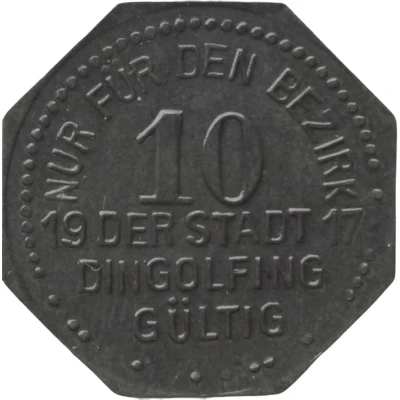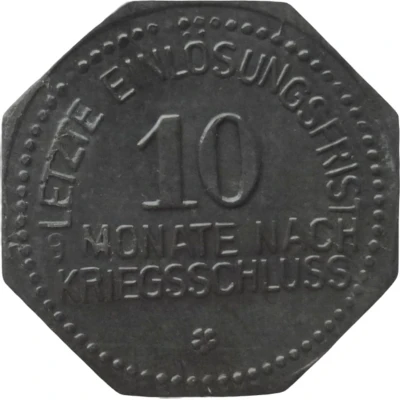


© Willem63 (CC BY-NC-SA)
10 Pfennigs - Dingolfing
1917 year| Zinc | 2.0 g | 20.8 mm |
| Issuer | City of Dingolfing (Federal state of Bavaria) |
|---|---|
| Emperor | William II (Wilhelm II) (1888-1918) |
| Type | Standard circulation coin |
| Year | 1917 |
| Value | 10 Pfennigs (10 Pfennige) (0.10) |
| Currency | Mark (1914-1924) |
| Composition | Zinc |
| Weight | 2.0 g |
| Diameter | 20.8 mm |
| Thickness | 1.0 mm |
| Shape | Octagonal (8-sided) |
| Technique | Milled |
| Orientation | Medal alignment ↑↑ |
| Demonetized | Yes |
| Updated | 2024-10-04 |
| Numista | N#199833 |
|---|---|
| Rarity index | 91% |
Reverse
Pearl rim, legend surrounding above denomination and below.
Script: Latin
Lettering:
LETZTE EINLÖSUNGSFRIST
10
3 MONATE NACH
KRIEGSSCHLUSS
Edge
Plain
Comment
Issuing authority: [Stadt, Bayern]Interesting fact
The 10 Pfennigs - Dingolfing 1917 coin was minted during a time of economic turmoil in Germany, known as the "Inflationary Period" (1914-1923). During this time, the value of the German mark (the national currency) plummeted, and prices for everyday goods skyrocketed. As a result, many Germans turned to alternative forms of currency, such as local emergency currencies like the 10 Pfennigs - Dingolfing 1917 coin, which was issued by the City of Dingolfing in Bavaria. Despite its small denomination, this coin is a fascinating piece of history that highlights the economic challenges faced by Germany during World War I and its aftermath.



